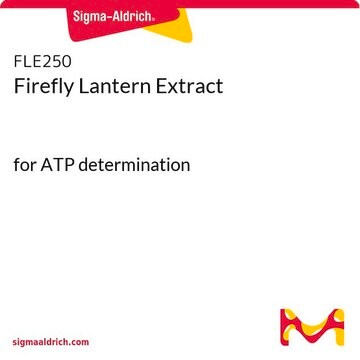R1258
Kpn I from Klebsiella pneumoniae
Restriction Enzyme
Se connecterpour consulter vos tarifs contractuels et ceux de votre entreprise/organisme
About This Item
Numéro CAS:
Numéro MDL:
Code UNSPSC :
12352204
Produits recommandés
Qualité
for molecular biology
Forme
buffered aqueous glycerol solution
Concentration
10,000 units/mL
Conditions d'expédition
wet ice
Température de stockage
−20°C
Vous recherchez des produits similaires ? Visite Guide de comparaison des produits
Spécificité
Recognition sequence: 5′-GGTAC/C-3′
Cutting results: a 2-10-fold Kpn I overdigestion of 1 μg λ DNA substrate results in 100% cutting
Heat inactivation: 65 °C for 15 minutes.
Cutting results: a 2-10-fold Kpn I overdigestion of 1 μg λ DNA substrate results in 100% cutting
Heat inactivation: 65 °C for 15 minutes.
Application
KpnI is a DNA restriction enzyme that is used in molecular biology research to cleave DNA at the recognition sequence 5′-GGTAC/C-3′ to generate DNA fragments with 3′-cohesive termini.
Autres remarques
Supplied with 10x Restriction Enzyme Buffer SL (B3782)
Comment: Kpn I shows abnormal DNA cleaving patterns (star activity) in reactions containing high (>5%) glycerol, >5% (v/v); excess enzyme and high pH (>8.0).
The enzyme will not cleave DNA containing 3′-residue of 5-methylcytosine.
The enzyme will not cleave DNA containing 3′-residue of 5-methylcytosine.
Forme physique
Solution in 20 mM Tris-HCl, pH 7.5, 0.1 mM EDTA, 50 mM NaCl, 10 mM 2-mercaptoethanol, 50% glycerol (v/v), 0.01% polydocanol (v/v) at 4°C
Produit(s) apparenté(s)
Code de la classe de stockage
12 - Non Combustible Liquids
Classe de danger pour l'eau (WGK)
WGK 1
Point d'éclair (°F)
Not applicable
Point d'éclair (°C)
Not applicable
Certificats d'analyse (COA)
Recherchez un Certificats d'analyse (COA) en saisissant le numéro de lot du produit. Les numéros de lot figurent sur l'étiquette du produit après les mots "Lot" ou "Batch".
Déjà en possession de ce produit ?
Retrouvez la documentation relative aux produits que vous avez récemment achetés dans la Bibliothèque de documents.
T Welsch et al.
American journal of physiology. Renal physiology, 281(4), F769-F777 (2001-09-13)
Mice lacking the 80-kDa CD2-associated protein (CD2AP) develop progressive renal failure that starts soon after birth with proteinuria and foot process effacement by unknown mechanisms. CD2AP has been identified and cloned independently by virtue of its interaction with the T
Karel De Gendt et al.
Proceedings of the National Academy of Sciences of the United States of America, 101(5), 1327-1332 (2004-01-28)
Androgens control spermatogenesis, but germ cells themselves do not express a functional androgen receptor (AR). Androgen regulation is thought to be mediated by Sertoli and peritubular myoid cells, but their relative roles and the mechanisms involved remain largely unknown. Using
J Tomassini et al.
Nucleic acids research, 5(11), 4055-4064 (1978-11-01)
We have determined the recognition sequence of the restriction endonuclease KpnI, previously isolated from Klebsiella pneumoniae. The enzyme cleaves the twofold rotationally symmetric sequence (see book for formula) at the positions indicated by the arrows, producing 3' protruding cohesive ends
C Kessler et al.
Gene, 92(1-2), 1-248 (1990-08-16)
The properties and sources of all known class-I, class-II and class-III restriction endonucleases (ENases) and DNA modification methyltransferases (MTases) are listed and newly subclassified according to their sequence specificity. In addition, the enzymes are distinguished in a novel manner according
Nico Mitro et al.
Methods in molecular biology (Clifton, N.J.), 952, 137-144 (2012-10-27)
The role of certain amino acids in the interactions of ligands with their cognate nuclear receptors is usually achieved by the resolution of the crystal structure of the receptor complexed with the ligand. As a complementary functional approach, site-directed mutagenesis
Notre équipe de scientifiques dispose d'une expérience dans tous les secteurs de la recherche, notamment en sciences de la vie, science des matériaux, synthèse chimique, chromatographie, analyse et dans de nombreux autres domaines..
Contacter notre Service technique







